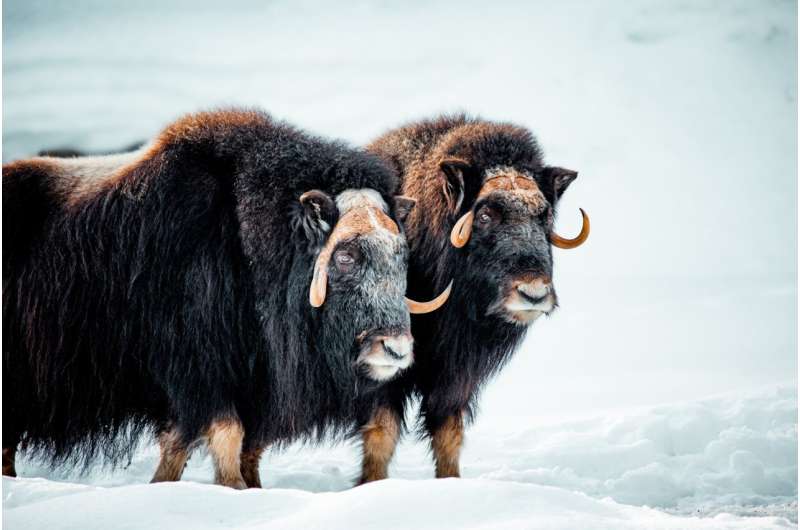This article has been reviewed according to Science X's editorial process and policies. Editors have highlighted the following attributes while ensuring the content's credibility:
fact-checked
peer-reviewed publication
trusted source
proofread
The genomic secrets to how the muskox mastered living on the edge

At the end of the last Ice Age, many iconic species became extinct—including the steppe bison, the wooly rhinoceros, the Irish elk, and the dire wolf. However, one Ice Age relict, perfectly adapted to the harsh climate of the tundra environment, has survived until the present day. Muskox escaped the destiny of its Ice Age compatriots and appears to be thriving in the world of today.
In new research published in Molecular Ecology, scientists investigate how the muskox mastered living on the edge—geographically, ecologically, and genetically.
The muskox lives at the northern edge of the world and native populations can be currently found in Canada and Greenland. To explore the eventful evolutionary history that brough the muskox here, a team led by Dr. Patrícia Pečnerová, who is a postdoc at the University of Copenhagen and Copenhagen Zoo in Denmark, analyzed whole genomes of more than 100 muskoxen.
Through challenging fieldwork in the High Arctic and collaboration with local communities and organizations, the team has secured samples from the most remote places in Canada and Greenland, and even one ancient muskox sample from Wrangel Island in Siberia, which was dated to ~21,000 years ago.
"Despite the wealth of genomic data that we were working with, reconstructing the muskox's past was an arduous task because life in the Arctic is complicated. A lot of the signals that we were getting from our analyses seemed contradictory," says Pečnerová, the first author of the study.
"Sometimes, however we like to fit our data into simple stories, we have to admit that the history was too complex to describe with the data that we have. It should not be a surprise, though. We already know from studies of other species in the Arctic that they have experienced complex histories that included periods of retreating to refugia, even local extinctions, as well as population expansions and recolonizations," she added.
What is clear from the results is that the muskox lost a big proportion of its genetic diversity in the last 20,000 years.
"By using an ancient Siberian genome, we were able to put the low diversity of present-day muskox into the context of their evolutionary history," explains Edana Lord from the Center for Palaeogenetics, who led the analyses of the ancient muskox.
Even the most diverse present-day muskoxen have only about a third of the diversity that the Siberian muskox had 20,000 years ago. In East Greenland, where the muskox arrived last on its long colonization journey, the level of genetic diversity is so low that there are only two variable positions for 100,000 base pairs.
This makes muskox the least diverse ungulate and puts it in the range where top predators usually end. If only the white-faced muskox, the subspecies living in the Canadian archipelago and Greenland, is considered, there is only one mammal that has lower diversity and that is a particular subspecies of a Channel Island fox.
Curiously, while most animals with similar levels of genetic diversity are iconic endangered species like cheetah, snow leopard or the white rhino, which number in thousands globally, the muskox is a geographically widespread species that counts about 170,000 animals.
How do muskoxen thrive almost without genetic diversity?
Reconstructing changes in population size through time, the researchers observed that the muskox started to decline already about 30,000 years ago, which is a time period that coincides with the maximum extent of the ice sheets covering Canada and Greenland. The slow and continued decline might have provided enough time for the most deleterious variation to be removed from the muskox' gene pool.
Pečnerová explains, "The way the muskox looks, behaves, and functions—it is extremely well adapted to the harshest of environments on this planet. Now we see that even genetically, they managed to draw a winning lottery ticket. It is almost surprising that they survived until present, but the way their evolutionary history unraveled, things just worked out for them."
However, whether it stays that way for the muskox is yet to be seen. It is well known that with the warming climate, Arctic species are facing new challenges. For the muskox, mild and humid winters are known to be a major risk as the animals cannot reach food through the crust on the snow. Moreover, there is already evidence of recent disease outbreaks, as pathogens and parasites are spreading further north. And with the little genetic diversity they have left, muskoxen are not particularly well equipped to adapt to these new challenges.
The study was an international effort that involved 31 co-authors led by researchers at the University of Copenhagen.
More information: Patrícia Pečnerová et al, Population genomics of the muskox' resilience in the near absence of genetic variation, Molecular Ecology (2023). DOI: 10.1111/mec.17205
Journal information: Molecular Ecology
Provided by University of Copenhagen



















